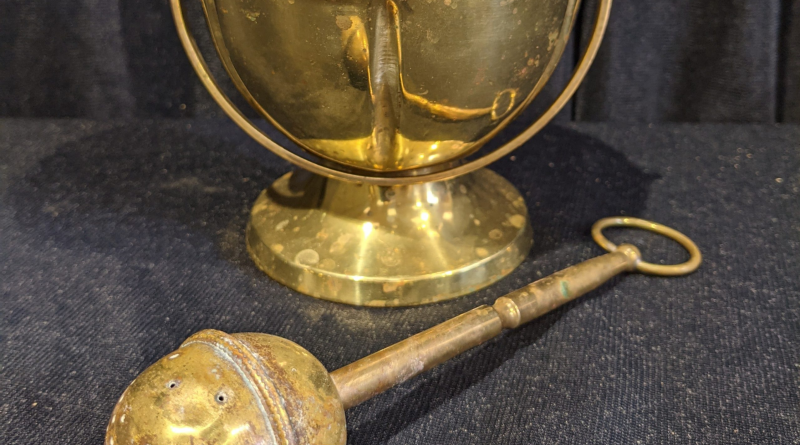The Fascinating World of Aspergillums: Exploring Sacred Water Dispensers in Christianity and Other Faiths
I was at Greek Fest recently The Priest or Father blessed me, and we had a delightful conversation. During the blessing, he used a fascinating instrument called an aspergillum. An aspergillum is a liturgical implement commonly used in Christian rituals to sprinkle holy water. It can take on three different forms. The first is a freshly cut hyssop branch, symbolizing purity and cleansing. The second form is a brush-like bundle that is dipped in the holy water and gently shaken to distribute the blessings. The third form is a perforated, mace-like metal ball with a handle, which allows for a controlled sprinkling of holy water. Some aspergillums are equipped with sponges or internal reservoirs that dispense holy water with each shake, while others need to be periodically dipped into an aspersorium, also known as a holy water bucket. Over the years, I’ve come across some intriguing examples of Sacred Water dispensers during research, a few other names in the Christian faith, and a few in other faiths also! and I’m excited to share them in this article:

- The form of the aspergillum differs in the Eastern Orthodox Church. In the Greek Orthodox Church the aspergillum (randistirion) is in the form of a standing vessel with a tapering lid. The top of the lid has holes in it from which the agiasmos (holy water) is sprinkled. In the Russian Orthodox Church the aspergillum is in the form of a whisk made of cloth or hair. Sometimes, sprigs of basil are used to sprinkle holy water. In some of the Oriental Orthodox Churches, no aspergillum is used, but the priest will pour holy water into the palm of his right hand and throw it on the faithful.
- The origin is found in the Book of Leviticus Chapter 14 in the Old Testament:
- And the priest goes out of the camp and the priest looks, and beholds that the sore of the leprosy of the leper is healed. And the priest commands and takes, for the one healed, two unblemished live birds, cedar wood, Coccus scarlet, and hyssop. And the priest commands and slaughters the one bird in a pottery vessel upon living water. He takes the live bird and the cedar wood and the Coccus scarlet and the hyssop and dips them and the live bird in the blood of the bird slaughtered upon the living water. And sprinkle seven times upon him purified of leprosy, and he is purified and sends the live bird upon the face of the field.
- Adam Clarke’s commentary:
- Of the cedar wood, hyssop, clean bird, and scarlet wool or fillet, were made an aspergillum, or instrument to sprinkle with. The cedarwood served for the handle, the hyssop and living bird were attached to it, by means of the scarlet wool or crimson fillet. The bird was so bound to this handle, as that its tail should be downwards, in order to be dipped in the blood of the bird that had been killed. The whole of this made an instrument for the sprinkling of this blood, and when this business was done, the living bird was let loose, and permitted to go whithersoever it would

The holy water dispenser is an invention credited to Hero of Alexandria, a Greek mathematician, and engineer who lived during the first century AD. The dispenser worked using a system of mechanical valves that controlled the flow of water through the device. The holy water dispenser was used in religious ceremonies to dispense holy water, a practice that dates back to ancient times in many cultures. The invention of the holy water dispenser is significant because it demonstrates Hero of Alexandria’s understanding of mechanical engineering and hydraulics. It also shows the importance of religion in ancient societies and the use of technology to aid in religious practices. In summary, Hero of Alexandria’s holy water dispenser was an important invention that demonstrated his understanding of mechanical engineering and the use of technology in religious practices. It is also a testament to the importance of religion in ancient societies.
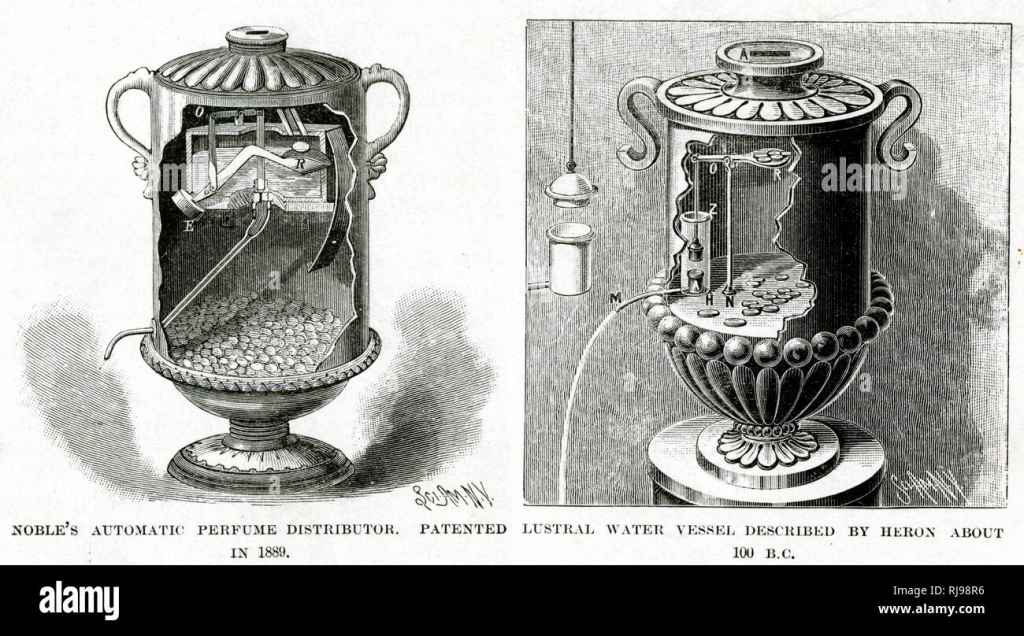
A pyx or pix (Latin: pyxis, transliteration of Greek: πυξίς, boxwood receptacle, from πύξος, box tree) is a small round container used in the Catholic, Old Catholic and Anglican Churches to carry the consecrated host (Eucharist), to the sick or those who are otherwise unable to come to a church in order to receive Holy Communion. The term can also be used in archaeology and art history to describe small, round lidded boxes designed for any purpose from antiquity or the Middle Ages, such as those used to hold coins for the Trial of the Pyx in England.
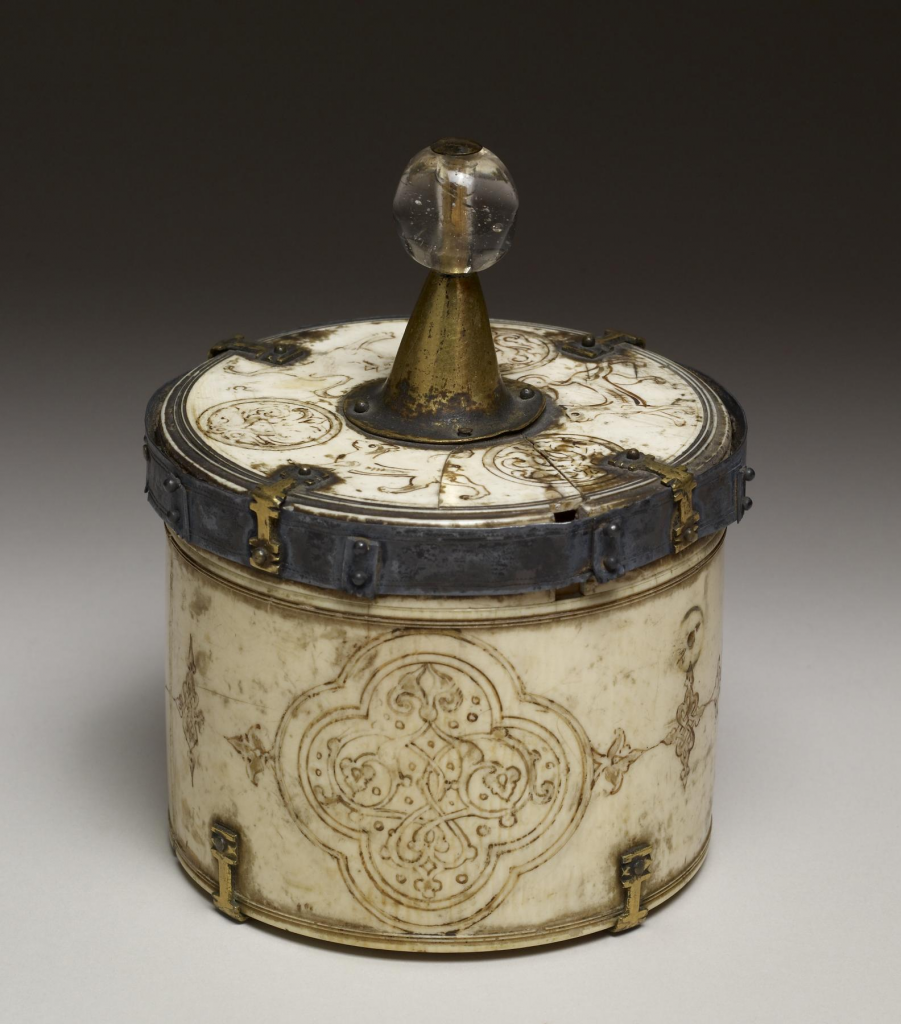
- Also see
- An altar cruet or mass cruet is a small jug used in mass to carry the water or wine that are used in the consecration. The current cruets have replaced the old amphoras that, with the name of hama or amula, were used to receive and carry the chalices of the wine that the faithful offered at Mass
- A ciborium is a vessel, normally in metal. It was originally a particular shape of drinking cup in Ancient Greece and Rome, but the word later came to refer to a large covered cup designed to hold hosts for, and after, the Eucharist, thus the counterpart of the chalice.
- A paten or diskos is a small plate, used during the Mass. It is generally used during the liturgy itself, while the reserved sacrament are stored in the tabernacle in a ciborium.
- A pyx or pix is a small round container used in the Catholic, Old Catholic and Anglican Churches to carry the consecrated host (Eucharist), to the sick or those who are otherwise unable to come to a church in order to receive Holy Communion.
- https://en.wikipedia.org/wiki/Sacred_waters
Other Faith’s examples of Holy or Sacred Water delivery systems, Uses, and beliefs
The use of holy water in Jewish tradition dates back centuries and has a rich history in religious practice.
While the specifics of holy water usage and dispensers may vary depending on the branch of Judaism, they are generally considered an important part of religious observance and spiritual purification.
The Zamzam Well (Arabic: بئر زمزم, romanized: Biʾru Zamzam Arabic pronunciation: [biʔru zam.zam]) is a well located within the Masjid al-Haram in Mecca, Saudi Arabia. It is located 20 m (66 ft) east of the Kaʿba,[2] the holiest place in Islam.
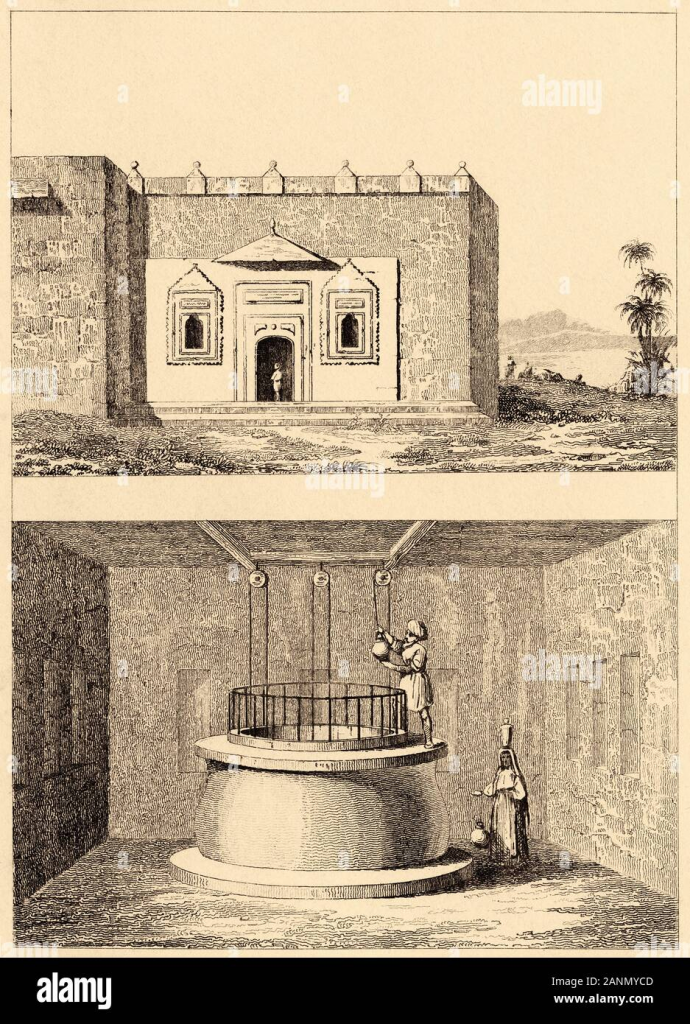
According to Islamic narratives, the well is a miraculously generated source of water, which opened up thousands of years ago when the son of Ibrahim (Abraham), Ismaʿil (Ishmael), was left with his mother Hajar (Hagar) in the desert. It is claimed to have dried up during the settlement of the Jurhum in the area and to have been rediscovered in the 6th century by ʿAbd al-Muṭṭalib, grandfather of Muhammad. Millions of pilgrims visit Mecca and Medina each year while performing the Hajj or Umrah pilgrimages in order to drink its water.
Sikhism
An 1880 photograph of the Golden Temple, sacred pool and the nearby buildingsOne of the holiest sites in Sikhism, Harmandir Sahib, is surrounded by a pool of water called amritsar or amritsarovar. For those who wish to take a dip in the pool, the Temple provides a half hexagonal shelter and holy steps to Har ki Pauri. Bathing in the pool is believed by many Sikhs to have restorative powers, purifying one’s karma. Some carry bottles of the pool water home particularly for sick friends and relatives. The pool is maintained by volunteers who perform kar seva (community service) by draining and desilting it periodically.
Sikhs use the Punjabi term amrita (ਅੰਮ੍ਰਿਤ) for the holy water used in the baptism ceremony known as Amrit Sanskar or Amrit Chhakhna.[51]
Sikhism
Further information: Golden Temple § Architecture 1880 photograph of the Golden Temple, sacred pool, and the nearby buildings

One of the holiest sites in Sikhism, Harmandir Sahib, is surrounded by a pool of water called amritsar or amritsarovar. For those who wish to take a dip in the pool, the Temple provides a half-hexagonal shelter and holy steps to Har ki Pauri. Bathing in the pool is believed by many Sikhs to have restorative powers, purifying one’s karma. Some carry bottles of the pool water home, particularly for sick friends and relatives. The pool is maintained by volunteers who perform kar seva (community service) by draining and desilting it periodically.
Sikhs use the Punjabi term amrita (ਅੰਮ੍ਰਿਤ) for the holy water used in the baptism ceremony known as Amrit Sanskar or Amrit Chhakhna.
A Hindu holy water dispenser is a container or vessel that is used to dispense water that has been blessed by a Hindu priest. This water is considered holy and is used for religious rituals and ceremonies.
In Hinduism, water is considered sacred and is believed to have purifying and healing properties. In many temples and holy sites, there are water tanks or fountains where devotees can bathe and purify themselves before entering the temple or performing a ritual.
The holy water dispenser is typically made of brass or copper and is designed with intricate carvings and motifs. It is often placed near the entrance of a temple or holy site so that devotees can use it to sprinkle water on themselves before entering.
The use of a holy water dispenser is an important part of Hindu religious practice and is believed to bring blessings and good fortune. It is also a symbol of the importance of water in Hindu culture and the belief in its power to cleanse and purify the soul.
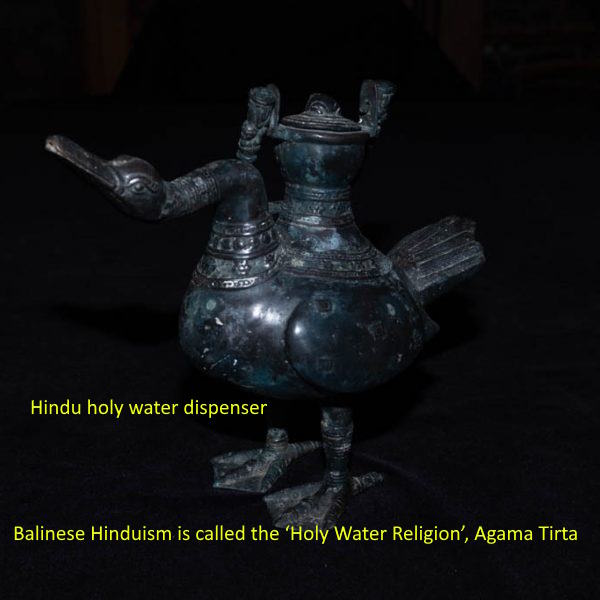
Balinese Hinduism is called the ‘Holy Water Religion’, Agama Tirta, which indicates the centrality of holy water in the religion. It is used in every ceremony, in every ritual, and poured over every offering, every sacrifice, every building, every rice field and every person. This sacred substance cleanses, blesses and purifies. It gets rid of evil and protects. At the end of prayers, the priest pours holy water over the person’s head. There are many varieties. https://www.nowbali.co.id/agama-tirta-balis-religion-of-water/
In Ancient Greek religion, holy water called chernips (Greek: χέρνιψ) was created when a torch from a religious shrine was extinguished in it. In Greek religion, purifying people and locations with water was part of the process of distinguishing the sacred from the profane.
A Bumpa with spout is a type of Tibetan sacred water vase that is used in Buddhist rituals and ceremonies. The Bumpa is usually made of brass or copper and is adorned with intricate designs and symbols. The spout is used to pour water during religious offerings or purification rites.
The Tibetan sacred water vase plays an important role in Buddhism as it is believed to hold the blessings of the Buddha and emit positive energy. According to Tibetan tradition, the water inside the vase is imbued with healing powers and can purify the mind, body, and soul.
During ceremonies, the Bumpa is filled with water and other auspicious substances like rice, flowers, or coins. The water is then used to sprinkle or pour over the participants to bless and protect them.

In conclusion, the Bumpa with spout is a crucial component of Tibetan Buddhism and embodies the essence of the religion’s teachings of compassion, mindfulness, and purification.
- Ancient Altar: An ancient altar refers to a raised structure used for offerings and sacrifices in religious ceremonies. These structures were used by many different cultures throughout history, including the Greeks, Romans, Egyptians, and Mayans.
- Cruet: A cruet is a small container used for holding liquids like oil or wine. This item is commonly found in religious ceremonies, such as in Catholic and Orthodox churches, where it is used to hold holy water or sacramental wine.
- Bowl: A bowl is a rounded, open-top container that can be used for a wide range of purposes. In religious contexts, bowls have been used for offerings, as well as for holding water or other liquids for purification or ritual use.
Together, an ancient altar, cruet, and bowl likely would have been used in religious ceremonies and offerings. The cruet and bowl would have been used to hold liquids for the ceremony, while the altar would have provided a raised surface for the offerings and sacrifices.

